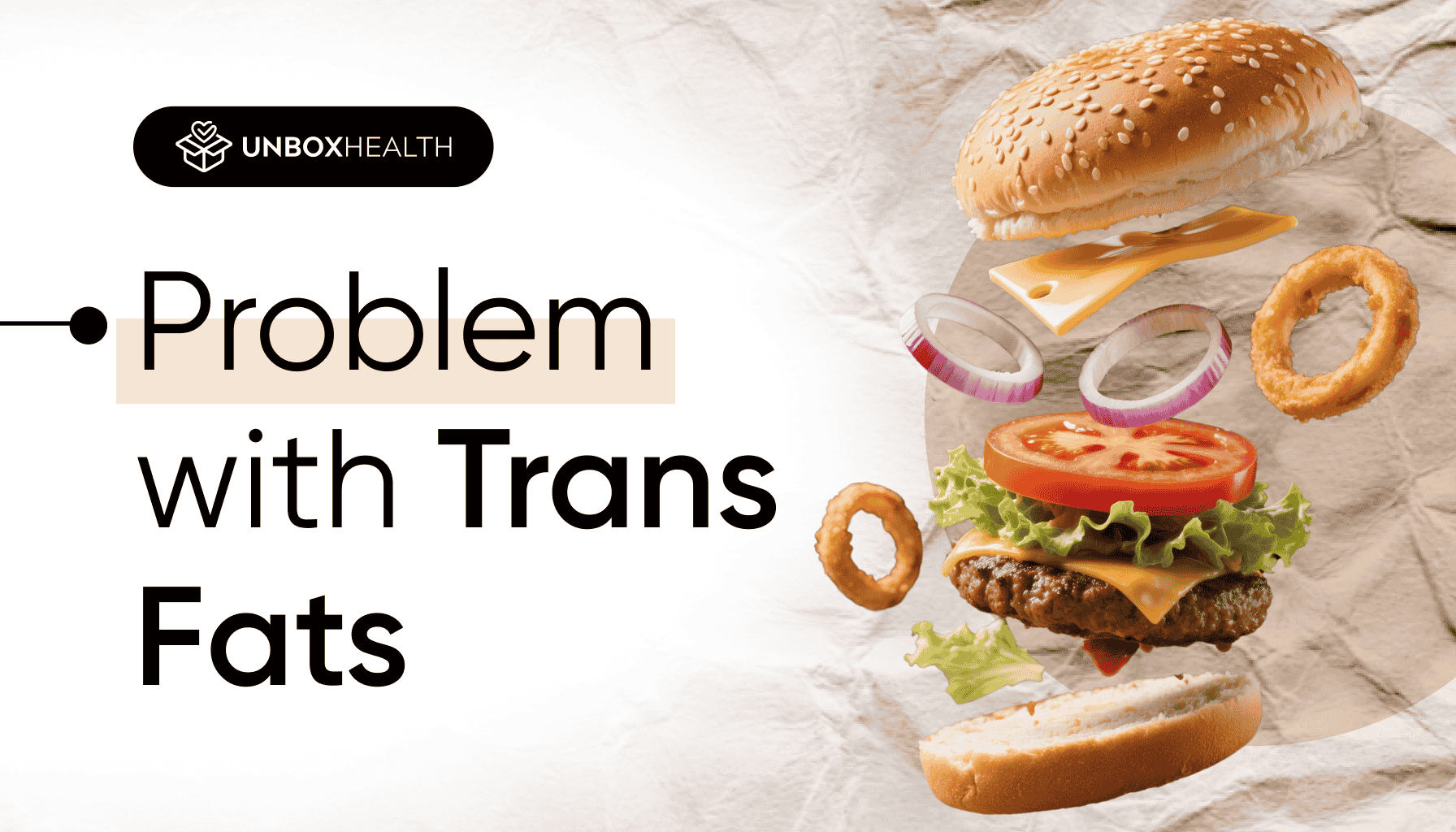Despite regulatory bans and packaging claims like “zero grams trans fat,” trans fats continue to make their way into Indian diets. Often hidden in everyday snacks and processed foods, these fats have been extensively studied and linked to adverse health outcomes even at very low intakes.
This article summarizes what trans fats are, why they remain a public health concern, and how to identify and avoid them, particularly in the Indian context.
What Are Trans Fats?
Trans fats, or trans fatty acids (TFAs), are unsaturated fats with at least one double bond in the trans configuration. They exist in two forms:
- Naturally occurring trans fats, produced by bacteria in the stomachs of ruminant animals. These are found in small amounts in dairy and meat products.
- Industrially produced (artificial) trans fats, generated during partial hydrogenation of vegetable oils. This process improves shelf life and texture, making these oils attractive for commercial frying, baking, and snack production.
Industrially produced trans fats are commonly found in:
- Bakery shortening, vanaspati, and margarine
- Fried foods such as chips and fast-food snacks
- Packaged biscuits, cookies, microwave popcorn, and ready-to-eat mixes
Biological and Clinical Impact of Trans Fats
Effect on Lipid Profiles
Numerous controlled studies demonstrate that trans fats increase serum low-density lipoprotein cholesterol (LDL-C) while decreasing high-density lipoprotein cholesterol (HDL-C). These shifts in lipid ratios significantly elevate cardiovascular risk [1,2].
Impact on Inflammatory Markers
Trans fat intake has been associated with elevated levels of inflammatory biomarkers, including C-reactive protein (CRP), tumor necrosis factor-alpha (TNF-α), and interleukin-6 (IL-6). These markers are predictive of vascular endothelial dysfunction and atherosclerosis [3].
Association with Glucose Dysregulation
Higher intake of trans fats has been linked to increased insulin resistance and fasting glucose concentrations. Observational and interventional studies support their role in the pathophysiology of type 2 diabetes mellitus [4].
Neural and Cognitive Effects
Emerging evidence suggests that trans fats may alter cell membrane fluidity and oxidative stress in the brain, contributing to neuroinflammation, cognitive impairment, and increased risk of Alzheimer’s disease [5].
Reproductive and Developmental Considerations
Data from both animal and human studies indicate that trans fats may interfere with fetal development, including gestational length, birth weight, and maternal blood pressure [6].
Food Labelling and Regulatory Gaps
In India, regulations permit food manufacturers to label products as containing “0 grams trans fat” if the content is less than 0.5 grams per serving. This loophole allows trace amounts to accumulate when multiple servings are consumed, particularly in commonly over-eaten foods like snacks, bakery products, and fried items.
In ingredient lists, industrial trans fats may be disguised as:
| Label Term | Typically Found In | Potential Health Impact |
|---|---|---|
| Hydrogenated oils (coconut, soybean, palm, vegetable) | Hydrogenated oils (coconut, soybean, palm, vegetable) Fried foods, protein powders, baked snacks | Raises LDL, lowers HDL, promotes systemic inflammation |
| Partially hydrogenated oils | Instant mixes, processed packaged foods | Associated with heart disease and insulin resistance |
| Vanaspati (hydrogenated vegetable fat) | Mithai (sweets), Indian fried snacks | Linked to chronic inflammation and artery thickening |
| Margarine | Bakery spreads, biscuits | Disrupts cholesterol balance, increases heart disease risk |
| Shortening | Pies, cookies, commercial pastries | Tied to obesity and metabolic dysfunction |
| Refined vegetable fat | Fast foods, pre-packed meals | Impairs metabolism, increases diabetes risk |
Trans Fats in Packaged Snacks: What Consumers Should Know
Packaged snacks, even those labeled “baked” or “trans fat-free,” may still contain industrially produced trans fats under the 0.5 g per serving threshold. This includes:
- Cream-filled biscuits
- Packaged namkeen
- Instant noodles
- Fry-ready frozen foods
- Cooking Oils/Ghee
- Chips & Puffs
Consumers must be vigilant by checking ingredient lists for hydrogenated fats and being cautious about portion sizes.
Check out unbiased lab-tested ratings of on Unbox Health along with their detailed lab reports.
About Unbox Health
Unbox Health: India’s First Ratings Platform for Packaged Foods and Health Supplement Tired of biased reviews and never-ending claims? At Unbox Health, every product is tested at multiple premium FSSAI-approved NABL-accredited international labs – 100% independently, transparently, and without any brand involvement.
- 100% Transparency: All lab reports are publicly published.
- Zero Hidden Agendas: Products are market-bought with no brand involvement.
- Accurate Testing: Samples tested at up to 3 premium international labs
- Actionable Ratings: Based on Label Accuracy, Toxicity & Nutritional Profile.
Head over to Unbox Health and let the data guide your consumption choices.
References
- Mozaffarian D, Katan MB, Ascherio A, Stampfer MJ, Willett WC. Trans Fatty Acids and Cardiovascular Disease. N Engl J Med. 2006;354(15):1601-1613. doi:10.1056/NEJMra054035
- Mensink RP, Zock PL, Kester AD, Katan MB. Effects of dietary fatty acids and carbohydrates on the ratio of serum total to HDL cholesterol and on serum lipids and apolipoproteins: a meta-analysis of 60 controlled trials. Am J Clin Nutr. 2003;77(5):1146-1155. doi:10.1093/ajcn/77.5.1146
- Baer DJ, Judd JT, Clevidence BA, Tracy RP. Dietary fatty acids affect plasma markers of inflammation in healthy men fed controlled diets: a randomized crossover study. Am J Clin Nutr. 2004;79(6):969-973. doi:10.1093/ajcn/79.6.969
- Louheranta A, Turpeinen A, Vidgren H, Schwab U, Gylling H, Uusitupa M. A high-trans fatty acid diet and insulin sensitivity in postmenopausal women. Metabolism. 1999;48(7):870-874. doi:10.1016/s0026-0495(99)90198-0
- Oishi M, Saito K, Nishijima T, et al. Trans fatty acid consumption and cognitive decline: findings from a 10-year prospective cohort study. Free Radic Res. 2018;52(5):527-539. doi:10.1080/10715762.2018.1452983
- Koletzko B. Trans fatty acids may impair biosynthesis of long-chain polyunsaturates and growth in man. J Pediatr. 1992;120(4 Pt 2):S129-S138. doi:10.1016/s0022-3476(05)81246-5
- Food Safety and Standards Authority of India. Gazette Notification on Trans Fat Limit Regulations. January 2021.
